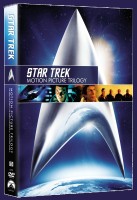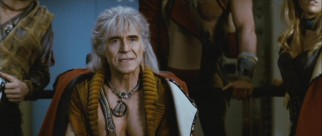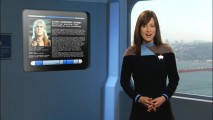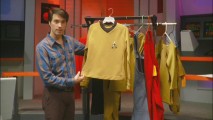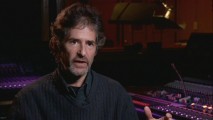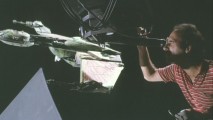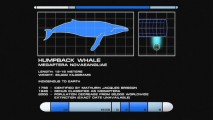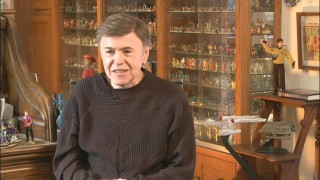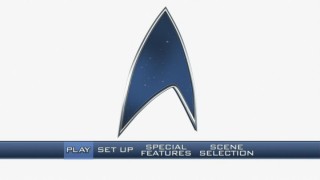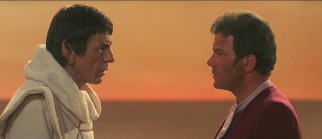Buy on DVD from Amazon.com Buy on Blu-ray from Amazon.com Buy 6-Movie Collection Blu-ray from Amazon.com
There are few franchises out there quite as expansive as Star Trek. What started out as a three-season sci-fi television series turned into eleven films, five more spin-off programs, a cornucopia of merchandise, and arguably the most devoted fan base of any media property. Collecting a trio of films and calling them a trilogy may seem peculiar when they're part of a series of 10 entries (11 with the new reboot). The reasoning behind this is that out of all those installments, three of them are directly linked to each other in a manner the others are not. 1982's The Wrath of Khan, 1984's The Search for Spock, and 1986's The Voyage Home make up the second, third, and fourth Trek films, respectively. Together, they tell the story of Project Genesis and how the crew of the USS Enterprise, led by Admiral James T. Kirk (William Shatner), use it to both their advantage and disadvantage.
Star Trek II: The Wrath of Khan is easily the most popular film in the series and it introduces Genesis. Not to be confused with the first book of the Bible or the Sega video game system, this device has the power to create new life forms on dead planets and matter. Should it be used where there is already life, however, any currently-living organisms would be destroyed to accommodate the new ones. While scouring for a dormant planet to test the device on, Commander Pavel Chekov (Walter Koenig) and Captain Clark Terrell (Paul Winfield) unintentionally run into Khan Noonien Singh (Ricardo Montalban). Khan was a terrorist who was marooned to the desolate planet of Ceti Alpha V fifteen years prior by then-captain Kirk (Shatner). The encounter gives Khan the perfect opportunity to seek revenge and steal the Genesis device for himself.
Out of the three features presented in this set, it's easy to see why Wrath of Khan is so highly regarded. It offers the tightest, most engaging story of the trilogy. It helps to have an actor with the strong talents of Ricardo Montalban. On paper, Khan seems fairly rudimentary, but Montalban infuses the character with charisma and intellect that make him more remarkable than he should be. William Shatner's iconic James T. Kirk has more character development here than in the following two installments. His acknowledgement of the years that have passed since the original series somewhat grounds the film in reality, allowing him to seem more well-rounded. This is also the most emotionally-charged picture of the three, ending with a climax that's surprisingly effective without feeling schmaltzy.
After the success of Khan, another installment was inevitable, especially with the seeds that were planted in that film. Thus came Star Trek III: The Search for Spock, which was less favorably received than its predecessor. There is no way to explain this storyline without spoiling the end of Khan, so it may be preferable to skip to the next paragraph if you haven't seen these movies. In Search for Spock, the crew of the Enterprise mulls over the death of Captain Spock (Leonard Nimoy). However, it is discovered that before his passing, Spock engaged in a mind-meld with Dr. Leonard "Bones" McCoy (DeForest Kelley). This act results in McCoy occasionally lapsing into Spock's way of thinking and leads to the realization that the Genesis has resurrected Spock. The crew attempt to head back to the newly-formed planet where the Vulcan's corpse was sent.
There is a famous belief among "Trekkies" that the quality of a Star Trek film relies on its numbering in the franchise. Supposedly all even-numbered entries are well-made while the odd-ones are noticeably poorer. Perhaps this is true to a vague extent, as The Search for Spock is the weakest of this DVD trilogy. However, it doesn't seem to be a radical step down from the surrounding pictures. The main concern is that very little actually happens until the third act. Much of the running time is devoted to the characters reminiscing about Spock and taking quite a bit of time figuring out simple realizations. Things finally pick up once Lieutenant Saavik (Robin Curtis, taking over the role originated in Wrath of Khan by Kirstie Alley) discovers Spock resurrected as a nine-year-old (played at this stage by Carl Steven). From here things remain consistently entertaining, especially with Christopher Lloyd holding his own as Commander Kruge in the little screen time allotted him.
The series took a distinctly different turn with Star Trek IV: The Voyage Home. Unlike the previous installments, this film skewed more towards comedy and was warmly received despite the tonal change. A destructive space probe threatens Earth, and the only way to be rid of it without casualties is to respond to its strange calls. The Voyage Home is the sort of installment in a film franchise that normally rings the death toll. With a ludicrous plot and a light-hearted, comedic tone in the midst of serious, epic film series, it should've been a train wreck the way similar entries have been for Superman and Batman. Inexplicably, it manages to intentionally amuse and fit with the surrounding pictures better than it should. Perhaps it's because, unlike other light-hearted sequels, this one doesn't pander in hopes of getting more children to attend. Even at its silliest, the humor remains fairly adult. There are, admittedly, some gags that come across a bit too campy, but these are more infrequent than expected. The biggest strength of the film is that, for once, the other crew members besides Kirk and Spock are allowed to shine. Usually, they're reduced to little more than plot devices, but here, each character has his own isolated storyline and character arc that helps keep the story fresh.
All three Star Trek films that make up this trilogy provide solid entertainment, but they all exhibit a common flaw: the storylines are rather threadbare. While it's most glaring in Search for Spock, the issue is present in both Wrath and Voyage, as well. Unlike another famous space saga, Star Trek has always been more about the characters than the plots. Even if one takes that into account, the meandering storylines still make themselves known. There's a wide variety of characters, and yet the writers don't always know what to do with them. Kirk and Spock are first and foremost the leads, and when there's not much for their characters to do, the films tend to pad the screen time with convoluted monologues. While these terminology-heavy discourses do help to expand the mythos and universe these characters play in, they can become a bit tedious after a while.
Still, when all is said and done, this Star Trek trilogy does what it sets out to do: entertain. Despite the different story approaches, all three films aren't as separated by huge gaps in quality as some may believe. They each offer similar strengths and weaknesses. Obvious levels of care and detail go into these productions and manage to come through in the final product. With interesting (if at times underused) characters, iconic performances, and some truly innovative ideas and effects, the Star Trek Motion Picture trilogy is a good sampling of one pop culture's most enduring phenomena. |
 |
Star Trek II: The Wrath of Khan
Theatrical Release: June 4, 1982 / Running Time: 113 Minutes / Rating: PG Director: Nicholas Meyer / Writers: Gene Roddenberry (television series), Harve Bennett, Jack B. Sowards Cast: William Shatner (Admiral James T. Kirk), Leonard Nimoy (Captain Spock), DeForest Kelley (Dr. Leonard "Bones" McCoy), James Doohan (Montgomery "Scotty" Scott), Walter Koenig (Pavel Chekov), George Takei (Hikaru Sulu), Nichelle Nichols (Commander Nyota Uhura), Bibi Besch (Dr. Carol Marcus), Merritt Butrick (Dr. David Marcus), Jeff McBride (Khan's Crewman), Paul Winfield (Capt. Clark Terrell), Kirstie Alley (Lt. Saavik), Ricardo Montalban (Khan), Ike Eisenmann (Midshipman Peter Preston), John Vargas (Jedda), John Winston (Cmdr. Kyle), Paul Kent (Lt. Cmdr. Beach) |
|
 |
Star Trek III: The Search for Spock
Theatrical Release: June 1, 1984 / Running Time: 105 Minutes / Rating: PG Director: Leonard Nimoy / Writers: Gene Roddenberry (series), Harve Bennett Cast: William Shatner (Admiral James T. Kirk), Leonard Nimoy (Captain Spock), DeForest Kelley (Dr. Leonard "Bones" McCoy), James Doohan (Montgomery "Scotty" Scott), George Takei (Hikaru Sulu), Walter Koenig (Pavel Chekov), Nichelle Nichols (Commander Nyota Uhura), Merritt Butrick (Dr. David Marcus), Phil Morris (Trainee Foster), Scott McGinnis (Mr. Adventure), Robin Curtis (Lt. Saavik), Robert Hooks (Adm. Morrow), Carl Steven (Spock, Age 9), Vadia Potenza (Spock, Age 13), Stephen Manley (Spock, Age 17), Joe W. Davis (Spock, Age 25), Paul Sorensen (Captain), Cathie Shirriff (Valkris), Christopher Lloyd (Commander Kruge) |
|
 |
Star Trek IV: The Voyage Home
Theatrical Release: November 26, 1986 / Running Time: 119 Minutes / Rating: PG Director: Leonard Nimoy / Writers: Gene Roddenberry (television series), Leonard Nimoy, Harve Bennett, Steve Meerson, Peter Krikes, Nicholas Meyer Cast: William Shatner (Admiral / Captain James T. Kirk), Leonard Nimoy (Captain Spock), DeForest Kelley (Dr. Leonard "Bones" McCoy), James Doohan (Commander Montgomery "Scotty" Scott), George Takei (Commander Hikaru Sulu), Walter Koenig (Commander Pavel Chekov), Nichelle Nichols (Commander Nyota Uhura), Jane Wyatt (Amanda), Catherine Hicks (Dr. Gillian Taylor), Mark Lenard (Ambassador Sarek), Robin Curtis (Lieutenant Saavik), Robert Ellenstein (Federation Council President), John Schuck (Klingon Ambassador), Brock Peters (Admiral Cartwright) |
VIDEO and AUDIO
All three films in the Star Trek Motion Picture Trilogy are presented in anamorphic 2.35:1 transfers. It's been reported that only The Wrath of Khan has received an extensive restoration while The Search for Spock and The Voyage Home were simply remastered. If that's truly the case, the differences may be more noticeable on Blu-ray than on DVD, for in this set all three look to be about the same. Each offers very clean images with no noticeable print flaws (except in a blizzard scene from the third film). Colors tend to look a bit muted, especially in the second film, but they seem reasonably accurate. The main two problems present are edge enhancement and artifacting. The former is only truly noticeable when dark figures are against light backgrounds, The Dolby Digital 5.1 surround soundtracks are also pretty adequate. Dialogue was comprehensible but at times came across as a bit hollow. Score and effects came off stronger, Surrounds were utilized more often than anticipated and gave the action sequences some life. The music as well remained fairly rich and strong. As expected, the clarity of all these components improved a bit with each installment.
BONUS FEATURES, MENUS, and PACKAGING This motion picture trilogy set drops all of the supplements created for each of the films in their previous Special Editions in favor of some new ones. The Wrath of Khan's collection begins with an audio commentary track by director Nicholas Meyer and "Star Trek: Enterprise" writer and producer Manny Coto. Meyer goes into great detail about the production, recounting various anecdotes and explaining the symbolism and deeper themes. He occasionally goes off on tangents, but Coto helps moderate the discussion, even if he can't help but gush about the feature presentation. Together, they both provide a well-rounded track that's the strongest of the three newly-produced ones.
Next comes "Starfleet Academy Scisec Brief 002: Mystery Behind Ceti Alpha VI" (3:08). Designed as a mock tutorial for Starfleet Academy students, this piece explains how Ceti Alpha V (the planet Khan was exiled to) might've switched places in orbit with Ceti Alpha VI (the planet Chekov and Terrell planned to use for Project Genesis). It's a slick and interesting examination.
"Collecting Star Trek's Movie Relics" (11:05) is a featurette hosted by Alex Peters, CEO of Propworx. He takes the viewer on a tour of different Star Trek memorabilia currently on public display. Along the way, he and other collectors weigh in their thoughts on these props and provide some backstory for many of them. It's always fascinating to see such archival material outside of its original context, and the comments provide fun trivia for fans.
"James Horner: Composing Genesis" (9:33) is a sit-down interview with the composer of both The Wrath of Khan and The Search for Spock. He touches on the different themes he created for both characters and situations, explaining the meaning behind his choices. His detailed reflections on both films and how they compare to both the original series and the first film make for a satisfying piece.
The final feature for the second film is "A Tribute to Ricardo Montalban" (4:44). Here, director Nicholas Meyer shares his personal experience working with the actor and relates some behind-the-scenes stories. Much of this information was already touched upon in the commentary, but it's still good to have a tribute to Montalban, who passed away four months before this DVD release.
The Search for Spock's supplements start with a commentary by Ronald D. Moore and Michael Taylor, two writers who participated in several Star Trek films and series from "Star Trek: The Next Generation" onward. Their lack of involvement in this specific picture means that they don't really divulge into this production. Instead, their track covers Star Trek in general, their personal experiences as writers, and how this film influenced them. It's not terribly enlightening as it's essentially a fan track, but devotees may want to give it a listen.
"Starfleet Academy Scisec Brief 003: Mystery Behind the Vulcan Katra Transfer" (2:42) continues the tutorial series, this time focusing on the mind meld. "Star Trek and the Science Fiction Museum and Hall of Fame" (16:51) starts with a one-on-one interview between Seattle Times critic Mark Rahner and Trek writer and producer Harve Bennett. Bennett details how he first came aboard the franchise and his goals for each of the films he worked on. After the chat, Rahner and Bennett tour the Science Fiction Museum, taking a look at the different Star Trek props on display. Lots of good information is covered in this feature, even if Rahner makes for a slightly irritating host.
"Industrial Light & Magic: The Visual Effects of Star Trek" (13:49) is perhaps the strongest of all the new featurettes. Various effects crew members from all three films breakdown how certain sequences where handled. The comments and film clips are interspersed with behind-the-scenes photos demonstrating the processes used. It truly makes one appreciate all the work that went into practical visual effects before CGI came along.
Finally, "Spock: The Early Years" (6:22) is an interview with Stephen Manley, who played Spock at age 17. He explains how he was cast, the specifics behind an intimate scene he shared with Robin Curtis, and fan interactions today. It's a fun and engaging look back.
Star Trek IV: The Voyage Home begins with another commentary, this time by Roberto Orci and Alex Kurtzman, writers of the 2009 Star Trek film. Like the Search for Spock's track, this boils down to a fan discussion that occasionally veers off into personal writing experiences with the franchise. The difference here is that Orci and Kurtzman are more engaging speakers and also relay more facts and trivia about both this film and Star Trek as a whole. That means more information is gleamed about the specific movie at hand than in the other track. It's a worthwhile listen.
Another educational piece emerges in "Starfleet Academy Scisec Brief 004: The Whale Probe" (3:41). Hosted by the same unnamed tutor from the previous two Scisec Briefs, this piece delves into the origins and characteristics of the whale probe that threatens planet earth. Because the probe is treated so vaguely in the actual film, this clip becomes useful, and the presentation remains polished.
"Star Trek for a Cause" (5:40) interviews several officials from Greenpeace about humpback whales and their relationship to humans. The Voyage Home's awareness of certain issues is touched upon, as is William Shatner's personal involvement with the cause. It comes across as a public service announcement, but at least it bears some relevance to the feature film.
"Star Trek: Three Picture Saga" (10:12) acts as a broad "making of" featurette for all three films in this set. Various crew members found in previous supplements are interviewed along with a few new ones. They all explain the links between the three films, canonical inconsistencies, and story ideas that never came into fruition. Despite the brevity, much is divulged here.
The final bonus feature for both this film and the whole set is "Pavel Chekov's Screen Moments" (6:10). The only main cast member to appear in any of these supplements, actor Walter Koenig reminisces about his expanded roles in both the second and fourth installments. All three discs behind with trailers for the new Star Trek film, "Star Trek": Season One on Blu-ray, and the original motion pictures on both DVD and Blu-ray.
Each film features the same menu interface. The main menus contain the iconic Starfleet logo spinning toward and away from the viewer while planets and constellations are reflected on it. The main theme from each respective installment plays over this animation. The submenus are static and silent, following a similar design of space reflections against a white background.
The gray discs come housed in a six-sided Digipak. The exterior of this lists all of the supplements and provides film summaries. The interior, where the discs are held, features the USS Enterprise and the USS Reliant battling in space. Each disc panel features the technical information for that respective disc. The Digipak slides into a cardboard slipcover that features embossment and reflective shine.
CLOSING THOUGHTS
The Star Trek Motion Picture Trilogy contains what most fans consider to be the three best films featuring the original Enterprise crew. While the light storylines tend to feel stretched, there's enough meaningful content in each to make them more substantial and entertaining. The new transfers are a mixed bag but lean more towards the positive side of that classification, while audio remains very good.
It comes as a disappointment that the commentaries and documentaries from the previous DVD releases aren't replicated here. The new features are well-produced, but work better as a supplement to the old collection rather than a replacement. To get both the new and old bonus material in one collection, one would have to turn to the more elaborate Blu-ray-only Star Trek Original Motion Picture Collection. That set contains the six films starring the original crew, accompanied by a wealth of supplements. This renders this Motion Picture Trilogy set somewhat useless for most. A mega box set of all eleven Star Trek installments seems inevitable sooner rather than later and would be a better purchase for Trekkies over either of these new sets. This trilogy is recommended as a rental for fans wishing to see the new transfers and supplements and for newcomers who wish to dip their toes into the Trek universe.
|
Related Reviews:
DVDizzy.com: New and Upcoming DVD & Blu-ray Schedule | DVD Reviews | UltimateDisney.com | Upcoming Cover Art | Search This Site
The Best of Star Trek: The Original Series, Volume 2 The Best of Star Trek: The Next Generation, Volume 2
Galaxy Quest: Deluxe Edition Stargate: The Ark of Truth The Black Hole Star Wars: The Clone Wars Cloverfield
20,000 Leagues Under the Sea Sunshine WALLE Escape from Witch Mountain The Hitchhiker's Guide to the Galaxy
Mystery Science Theater 3000: 20th Anniversary Edition Lost: The Complete First Season
Big Film Franchises: Planet of the Apes James Bond: Blu-ray Collection (Volumes 1 and 2) The Godfather Trilogy (The Coppola Restoration)
New to DVD: The Jetsons: Season 2, Volume 1 C.S.I.: Crime Scene Investigation - The First Season (Blu-ray) Action Packed: T.V. Sets
1980s: Poltergeist (25th Anniversary Edition) Indiana Jones and the Temple of Doom Flight of the Navigator Voyagers!: The Complete Series
Ricardo Montalban: Freakazoid!: Season 1 Esther Williams Collection Kim Possible: The Villain Files
Child's Play (Chucky's 20th Birthday Edition) Buzz Lightyear of Star Command: The Adventure Begins Gargoyles: The Complete First Season
UltimateDisney.com/DVDizzy.com Top Stories:
Reviewed May 31, 2009.
Text copyright 2009 DVDizzy.com. Images copyright 1982-1986 Paramount Pictures and 2009 Paramount Home Entertainment. Unauthorized reproduction prohibited.
